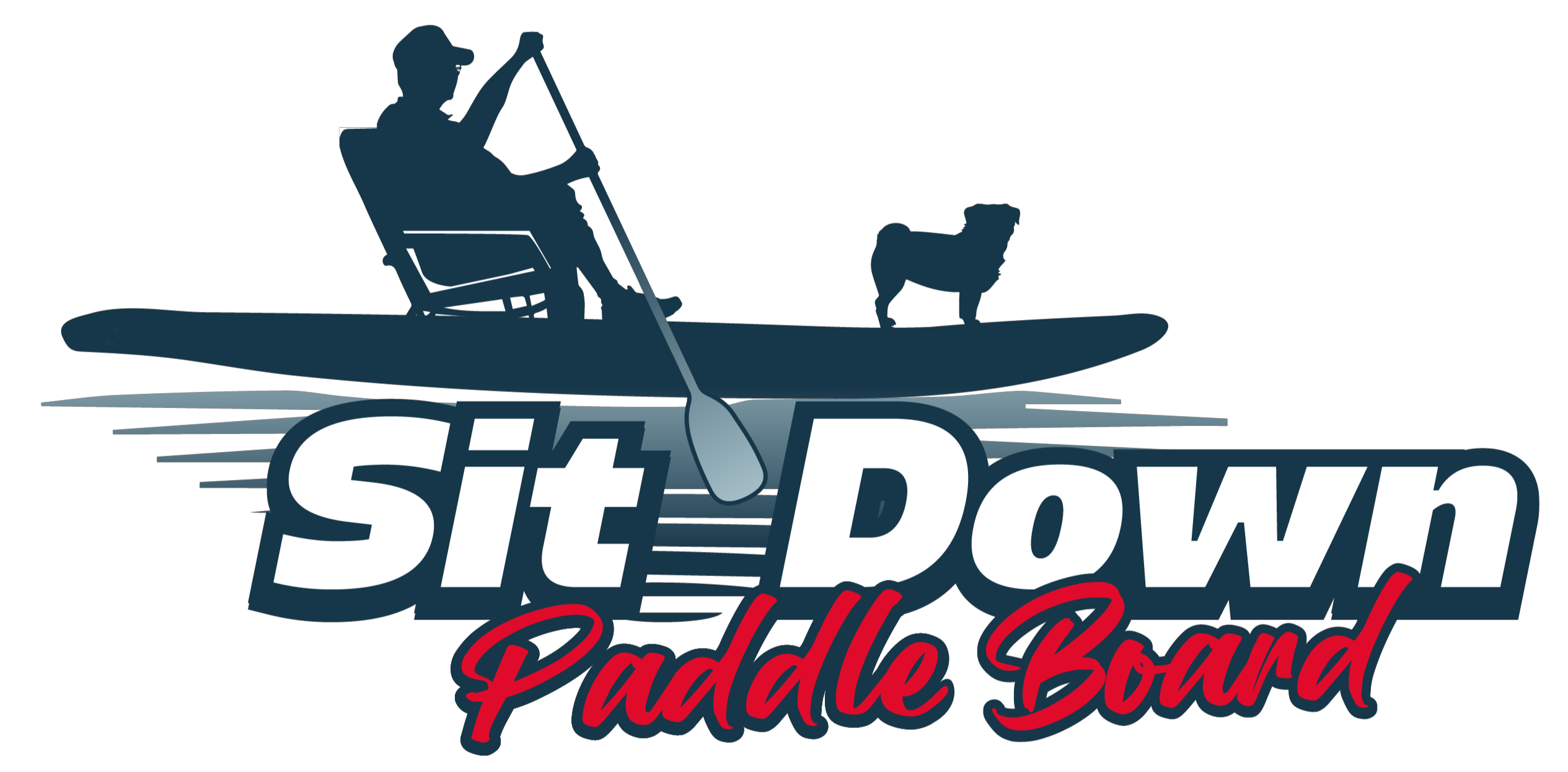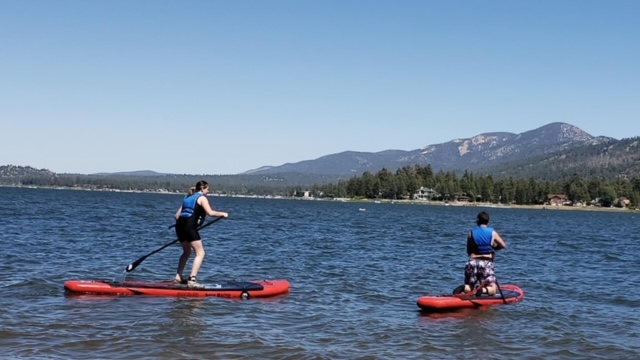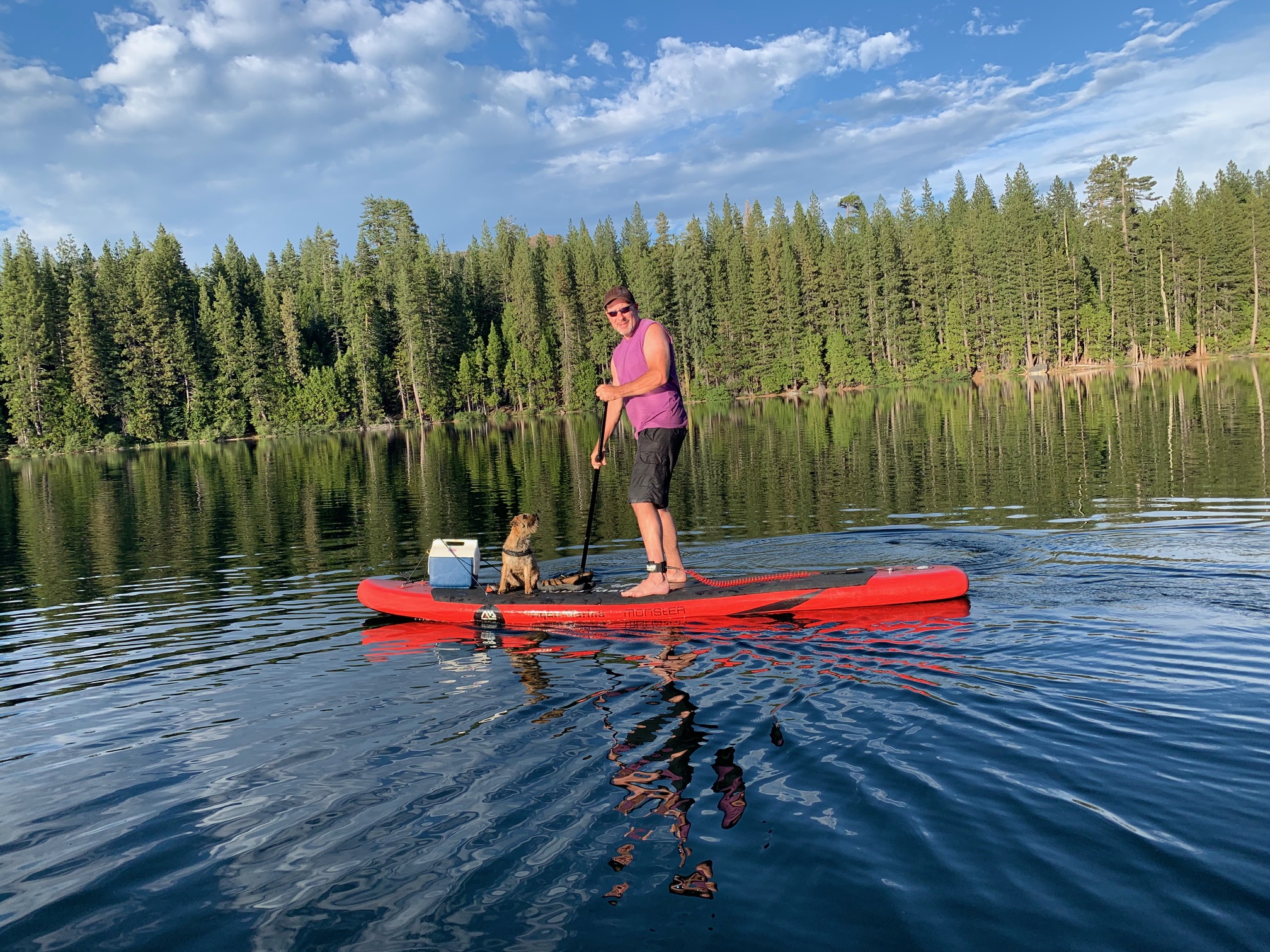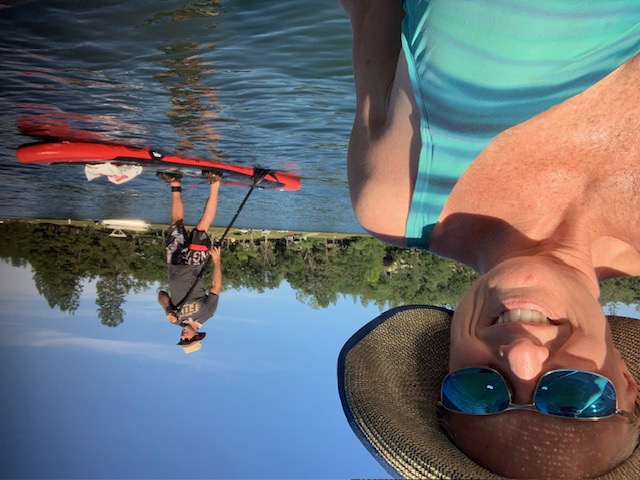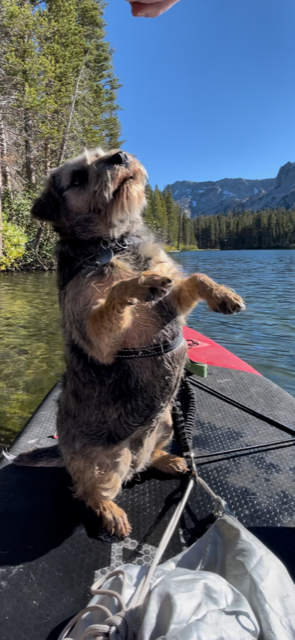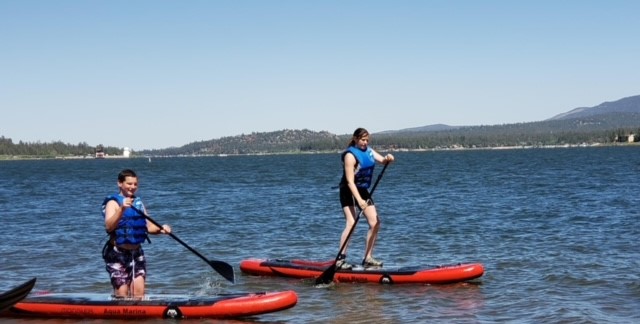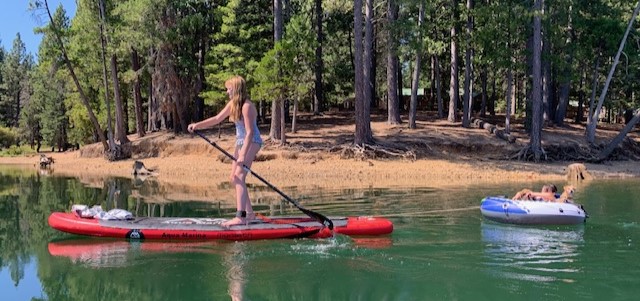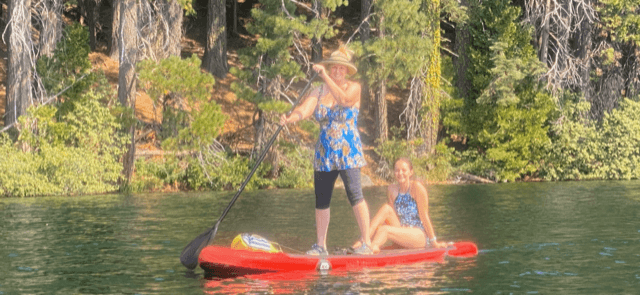10 Important Stand Up Paddle Boarding Tips
Here are ten of our most important stand up paddle boarding tips to ensure you get off to a strong start in your paddle boarding journey. We created this list so you can avoid the most common first time paddle boarder mistakes. Whether you are renting a SUP to paddle, you’ve just bought your own gear, or you’ve been out a few times, this information will ensure you have a great experience.
The Tether of Life - Your Leash
Just like superheroes aren't complete without their cape, likewise, a stand up paddle boarder isn’t really fully equipped without their leash. Of all of our stand up paddle boarding tips, this one is the most important. Remember, leashes aren't just fashionable ankle accessories reminiscent of 80s punk rock bands, they're life-savers.
Harness your SUP board with a leash - it’s your lifeline when the going gets tough. Think of it as the invisible umbilical cord that keeps you tied to your aquatic survival kit i.e. your paddleboard. This bond with your board can alter the fate of an adrenaline-pumping adventure into a 'Titanic' disaster; chilling, isn't it?
Fierce winds, strong currents, or mischievous waves may try to separate you from your "floating oasis". But with a leash in place, your board stays by your side like a loyal buddy, defiantly facing all the aquatic tantrums together.
Even if you happen to drop your paddle, don’t fret. It will float around like a bobbing apple waiting for you to retrieve it as you lay safely perched on your board.
The leash is a two-fold superhero: one, it saves your own skin by acting as your lifeline; and two, it rescues others around you from being in the path of an untethered, unruly paddleboard. Uncontrolled boards can easily go from friendly floaters to dangerous drifters.
So, leash up! It's your little safety tether that packs a punch of security! So, before suiting up, ensure you've selected the right leash – your superhero cape - for your paddle boarding adventure.
Paddle Direction - More Important than One Direction
We've all been victims of having our paddle facing the wrong way at least once, scooping the water like we're ladling soup because it felt right at that moment. However, the "aha" moment soon hits us as the paddle does work more effectively while standing, and results in a smoother stroke with lesser strain on your upper limbs. It's similar to trying to row your boat with the backside of the spoon, simply a futile and comedic endeavor!
Identifying the problem is simple, the concave part of your paddle should be facing the back of your paddle board when you are paddling. Its and easy fix, simply turn it around (preferably before anyone else notices…)!
Board Facing - Fins at the Back, Not a Mullet Style
Board style preparation can often be as confusing as fashion trends - what way is front and back, anyway? The broad end of the board could easily trick any beginner into thinking it's the nose/front of the board. Well, it's actually fins at the back! Just like how a properly trimmed beard helps shape a face, fins help shape your paddle boarding experience by creating a stabilizing rudder and providing traction when riding waves.
So remember, the fins go behind you when you paddle!
Be A Core Player, Not an Arm Wrestler
Contrary to popular belief, paddleboarding has less in common with arm wrestling and more affiliation with a strong core workout - yes, you can finally work on those abs!
Standing and rowing only with your arms will exhaust you in no time, leave you sore the next day and won’t give much power to your strokes.
The key to strong paddling is to keep your arms fairly straight and use your shoulder, stomach and back muscles to move your paddle. These are much larger muscle groups so they will tire slower and allow you to have a much more efficient stroke.
If you have them, those six-pack abs are finally going to pay off, providing a powerful, efficient paddle stroke and transforming your SUP experience from exhausting to exhilarating. If you don’t have them, paddle boarding is a great way to get them!
Eyeing The Horizon, Not Your Toes
It's not uncommon for first-time paddle boarders to constantly glance at their feet, as checking to make sure they are still on the board. Looking down will make you feel wobbly. Have you ever tried walking while looking at your feet? Not only do you lose track of where you are, you are much more likely to stub a toe or trip on a curb you didn’t see in time.
Instead, you should look at the horizon so that your body will naturally compensate for any waves and for your paddling action. For better stability, ensure your back remains straight, with your eyes set on the horizon. Bend your legs slightly at the knees and keep your weight distributed evenly if not slightly over your toes.
Stand proud on your board. Looking at your feet is like attempting to walk on a tightrope while looking down - an open invitation for a watery embrace!
Space, The Final Frontier
As a beginner, giving yourself, other paddlers, and water inhabitants some elbow room is crucial. We don’t need to turn our paddle boarding sessions into real-life bumper car games, do we?
This is especially true when you are just starting out and are not experiences at maneuvering your board and when it is more likely that you might fall off. No one likes to fall off their board because someone paddling too close bumps into them with their board. We often see this happen when one person falls off and their board shoots out from under them and into someone close by before their leash catches it.
Plus, having more space will allow you to relax and enjoy learning to paddle since space gives you more options if you get nervous or are having trouble mastering your board.
Falls Beget Great Stories
Just as one cannot make an omelet without breaking a few eggs, a few tumbles are an integral part of your SUP story. This is the most reassuring of our stand up paddle boarding tips. One of the biggest reasons that we love paddle boarding is that grazed knees or a bump on the head are not part of the adventure like they would be if you were mountain biking.
Unless you are paddling in surf where there are lots of rocks or a reef, the worst thing that is likely to happen is that you will get wet.
Even if you belly flop, the chances that you will surface with a smile is very likely. Even if you aren’t smiling, your friends will be … especially if they got it on tape!
Unless the water is super cold and there is snow on the ground in which you may prefer to sit down paddle board like Julie does any time she doesn’t feel like getting wet or when her back is hurting her!
So remember while you are learning to paddle board, there is no reason to be stressed. Enjoy the experience. The worst thing that can happen is you will fall into the water.
Choose Your Waves Wisely
We all have debated between courage and foolishness as we tried to brave those towering waves or rush through the intimidating white waters. White-knuckle adventures may provide adrenaline rush but remember, the ocean isn't going anywhere.
Out of all of our stand up paddle boarding tips, our paddling environment is the easiest one to control. When you are learning it is best to pick places where the water is flat and you only have to deal with occasional waves, like on a lake.
You should also pick a time when it isn’t very windy because the wind will push you around and create waves. There is typically less wind in the morning and there is less wind in protected coves on a lake.
The right surf conditions can make your SUP experience a real splash!
Wind Tales
Do check the weather before heading out! Also be aware that wind typically kicks up in the afternoon.
If you are somewhere that the wind always comes from one direction, then paddle into the wind as you head away from where you launch so that if the wind does kick up you can turn around and let the wind push you back to where you started.
If you happen to be caught in a fierce wind, sit down. Your body acts like a sail so standing up and paddling into a strong wind is very difficult and you can get blown off course, especially if you are just learning to paddle. Unless you want a really good work out or don’t mind a hike back to where you started, just sit down. Not only will you feel much more stable, but it will be easier to control your board and you will have very little trouble paddling back to where you started.
Julie almost always brings a seat folded up in the front of her paddle board since we go on long paddling expeditions and she finds it both comfortable and easy to paddle back to where we started with her trusty folding stadium seat.
Board-care, Not Just Healthcare
Remember, paddle boards have feelings too; more the reasons while they are built out of expensive lightweight materials. Rough handling on land could lead to damaging your paddleboard which in turn, hurts your pocket. Treat your board with tender, loving care and it will return the favor tenfold in the water!
The two most important things to do to care for your inflatable paddle board are to rinse off any sand or dirt before you lift your board out of the water. Then carry it to your vehicle or lean it on something so that it can dry completely before you roll it up and store it back in its bag. We always store our paddle boards in a heavy canvas zippered bag. Of all of our stand up paddle boarding tips, this one can save you the most money because while inflatable boards are very durable, it is much easier to puncture them or abrade them if they are not stored properly.
We have found that rolling our paddle boards up starting at the nose and ending at the tail where the air valve is works the best.
Bonus stand up paddle boarding tips
We hope you have enjoyed these 10 important stand up paddle boarding tips. We have two final tips for you…
Get a paddle board that is optimized for beginners. This doesn’t not mean that experts can’t ride it… we ride some of the same boards we started out with. Its just that the length, width, thickness and other features can all make a huge difference when it comes to how fun, stable and maneuverable the board will be. To learn more read our article about the Best Paddle Board for Beginners.
And finally, stand up paddle boarding is just one way that you can enjoy being out on the water on a paddle board. Read about all of the different Ways to Paddle Board.
We hope to see you out on the water!
